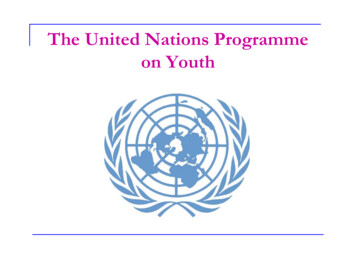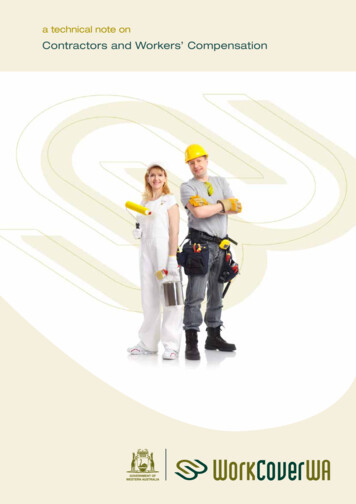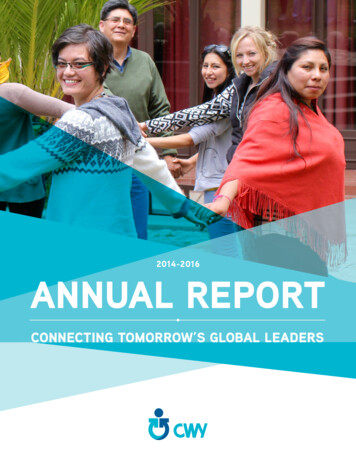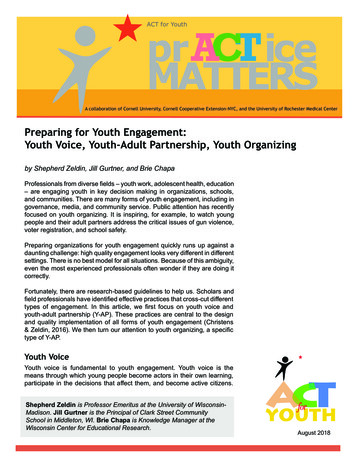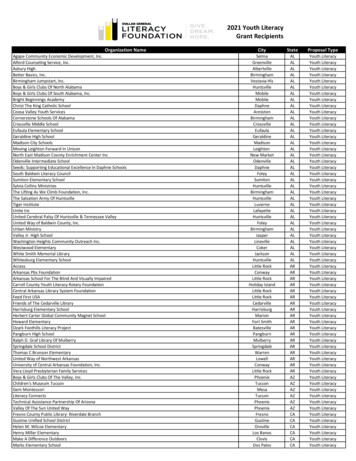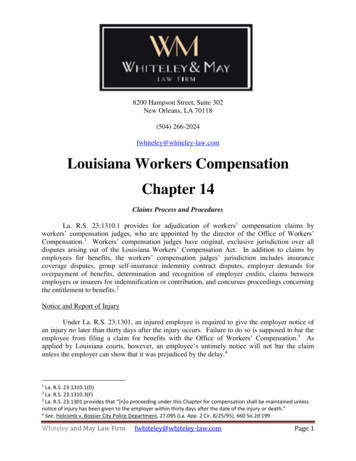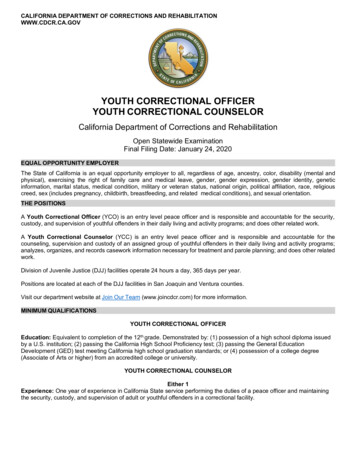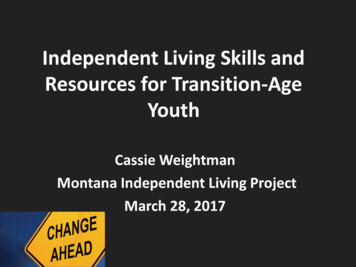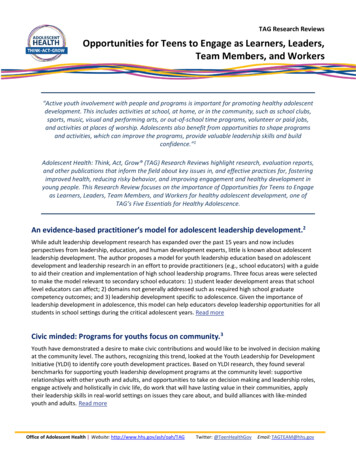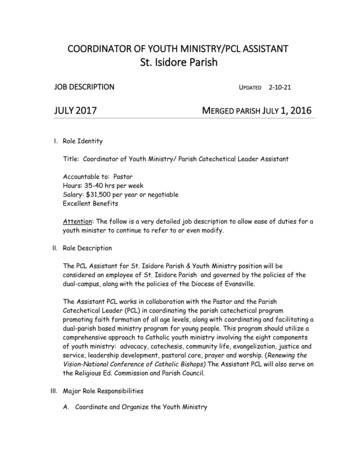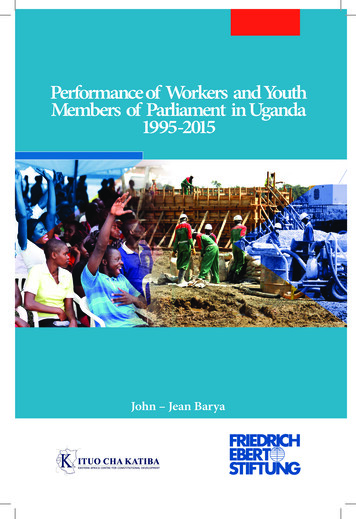
Transcription
Performance of Workers and Youth Members ofParliament in Uganda 1995-2015iPerformance of Workers and YouthMembers of Parliament in Uganda1995-2015John – Jean Barya
iiPerformance of Workers and Youth Members ofParliament in Uganda 1995-2015
Performance of Workers and Youth Members ofParliament in Uganda 1995-2015Performance of Workers andYouth Members of Parliamentin Uganda 1995-2015iii
ivPerformance of Workers and Youth Members ofParliament in Uganda 1995-2015ISBN No. 978-9970-535-01-9Published in 2017 byFriedrich-Ebert-StiftungKampala, Uganda.5B Acacia AvenueP.O. Box 3860www.fes-uganda.orgCopy Editor: Nangula ShejavaliDesign and Image by: New VisionDisclaimer: The findings, interpretations and conclusions in this volume do notnecessarily reflect the views of the Friedrich-Ebert-Stiftung (FES) and Kituo chaKatiba (KcK). FES and KcK do not guarantee the accuracy of data included in thiswork. FES bears no responsibility for over sights, mistakes or omissions.The sale or commercial use of all media published by the Friedrich-Ebert-Stiftung isprohibited without the written consent of FES. This work is licensed under the Creative commons’ Attribution - NonCommercialShareAlike 2.5 Licence.
Performance of Workers and Youth Members ofParliament in Uganda 1995-2015vTable of contentsList of Abbreviations and AcronymsviForewordix1.0Introduction and methodology12.0Literature review43.0The legislative role of workers’ and youthMPs in parliament 1995 - 20154.0The relationship between workers’ and youth MPs,the ministry of gender, Labour and social Developmentand constitutional bodies295.0Are these MPs needed? Vacillation from reformof elections, mode of operation and facilitationto complete abolition386.0Accountability: reporting and feedback mechanisms497.0Conclusions and aire/interview guide on Workers’Appendix - Iand Youth MPs’ representative role in parliamentAppendix - IIInterview Schedule MoGLSDAppendix - III Interview Schedule MPsAppendix - IV Interview Schedule EOCAppendix - VInterview Schedule ULRCAppendix - VI Interview Schedule UHRCAppendix - VII Interview Schedule Trade Unions, NGOs andAcademicsAppendix - VIII List of Respondents and Key Informants6064677073767982
viPerformance of Workers and Youth Members ofParliament in Uganda 1995-2015LIST OF ABBREVIATIONS AND RMNSSFNUEINUPAWNUSAFNUSUAmerican Federation of Labour and Congress ofIndustrial OrganisationsAfrican Growth and Opportunity ActAcquired Immune Deficiency SyndromeAllied Workers’ UnionAfrican Youth Development LinkBank of UgandaConstituent AssemblyChief Administrative OfficerChama Cha MapinduziCentral Governing CouncilCentral Organisation of Free Trade UnionsDemocratic PartyEast African CommunityEast African Common Market ProtocolEqual Opportunities CommissionFriedrich Ebert StiftungFocus Group DiscussionFederation of Uganda EmployersGovernment of UgandaHuman immunodeficiency virusInternational Labour OrganisationInternational Textile, Garment, Leather Workers’ FederationKituo cha KatibaKabaka YekkaMinistry of Finance, Planning and Economic DevelopmentMinistry of Gender, Labour and Social DevelopmentMemoranda of UnderstandingMembers of ParliamentMakerere University Academic Staff AssociationNational AssemblyNational Agriculture Advisory Development ServicesNational Development PlanNon Governmental OrganisationNational Organisation of Trade UnionsNational Planning AuthorityNational Resistance ArmyNational Resistance CouncilNational Resistance MovementNational Social Security FundNational Union of Education InstitutionsNational Union of Plantation and Agricultural WorkersNorthern Uganda Social Action FundNational Union of Students of Uganda
Performance of Workers and Youth Members ofParliament in Uganda ULSUNATUUNDPUNSAUPCUPDFUPEURAUSUSAUSEUTGL & AWUUTUCUYONETWBYESYLPviiNational Union of Youth OrganisationsNational Youth CouncilPay as You EarnPlatform for Labour ActionPersons with DisabilitiesResident District CommissionerSouth Western Initiative for Community Counselling OrganisationTanganyika African National UnionUganda Human Rights CommissionUnited KingdomUganda Law Reform CommissionUganda Law SocietyUganda National Teachers UnionUnited Nations Development ProgrammeThe Uganda National Students’ AssociationUganda People’s CongressUganda Peoples Defence ForcesUniversal Primary EducationUganda Revenue AuthorityUnited StatesUnited States of AmericaUniversal Secondary EducationUganda Textile, Garment, Leather and Allied Workers’ UnionUganda Trade Union CongressUganda Youth NetworkWorld BankYouth Enterprise (Credit) SchemeYouth Livelihood Programme
Performance of Workers and Youth Members ofviii Parliament in Uganda 1995-2015
Performance of Workers and Youth Members ofParliament in Uganda 1995-2015ixFOREWORDSpecial interest group representation in parliament is one of the unique featuresof Uganda’s 1995 Constitution. It also distinguishes Uganda’s parliament fromthe rest in the East African region. Although workers were privileged to have hadtwo representatives in the 1989 Constituent Assembly that debated Uganda’s 1995constitution, special interest group representation in parliament was embedded as anaffirmative action measure. The 289- member Constituent Assembly included theyouth, women, persons with disability (PWD), workers and the army. The youth,women and PWDs were largely included to overcome historical imbalances andmarginalisation in society, while for the army and workers; it was because of thehistorical role they played in Uganda’s political trajectory. This representation washowever subjected to review ten years after the commencement of the Constitutionand every five years thereafter for purposes of retaining, increasing or abolishing anysuch representation.Whereas this review has not escaped parliament since, there is recent and growingconcern over the relevance of special interest groups especially with regard to theireffectiveness in serving the interests and needs of their constituencies as well asover the process of their review. The mode of review has been through motionsin parliament supported by show of hands. This coupled with the historic value ofaverting discrimination with which special interest groups have been associated,necessitated Kituo cha Katiba: Eastern Africa Centre for Constitutional Development(KcK) with support from the Friedrich-Ebert-Stiftung (FES) in 2015 to undertake astudy An Appraisal of Two Decades of Advancing Rights and Interests of Youth andWorkers under the 1995 Uganda Constitution. The study examined more closely therole of the youth and workers Members of Parliament in promoting and advancing therights and interest of their constituencies as envisaged under the 1995 Constitution,government policies and programme and relevant laws. It also examined linkagesbetween the special interest members of parliament and the role of constitutionalbodies in protecting the two special interest groups.The findings of the study are a collation of relevant literature on the subject and theviews of various key stakeholders in seven districts of Uganda. They were shared anddiscussed with various key stakeholders from across the country and benchmarks forassessing the performance in parliament of youth and workers MPs evolved as a finaloutput.It is FES and KcK’s earnest belief and hope that both the findings and benchmarksfrom this project will constitute a useful tool for both the constituents and Youth andWorkers MPs in strengthening the legislative role of the MPs as well as accountabilityto their constituencies.We would like to register our deepest appreciation to the consultants who conductedthe study; all the respondents for their useful insights and candidness during the study,
xPerformance of Workers and Youth Members ofParliament in Uganda 1995-2015and the invaluable contributions of all stakeholders who participated in the validationworkshop and successive dialogues that concretised the study findings.Edith KibalamaExecutive DirectorKituo cha Katiba
Performance of Workers and Youth Members ofParliament in Uganda 1995-20151.01INTRODUCTIONThis study intends to review and appraise the legislative role of workers’ and youthMembers of Parliament (MPs) in promoting and advancing the rights and interestsof their constituencies, namely workers and youth, as envisaged under the 1995Constitution, government policies and programmes, and relevant laws.In particular, this study intends to achieve the following:1.Assess the performance of youth and workers’ MPs in the Parliament ofUganda in executing their mandate, especially in advancing the rights andinterests of the two special groups over the past two decades;2.Assess the impact of their work in advancing the rights and interests ofyouth and workers in terms of legal, policy and programme reform;3.Examine linkages between special interest MPs and the role ofconstitutional bodies in protecting the two special interest groups;4.Assess available mechanisms of consulting and obtaining feedback fromworkers and youth and their effectiveness, including linkages with localgovernments;5.Assess the work and impact of constitutional bodies in advancing the rightsand interests of youth and workers and exploring the practical linkagesbetween legislative representation, constitutional bodies and the parentministry, that is the Ministry of Gender, Labour and Social Development(MoGLSD), in advancing the rights and interests of youth and workers;6.Use any other available measures to assess performance;7.Provide recommendations for a more robust and meaningful approach onhow rights and interests of youth and workers can be delivered throughlegislative representation, including mode of elections, benchmarks formeasuring performance of the MPs; methods of consultation, outreach andfeedback with the respective constituencies; and structural linkages with keystakeholder institutions/bodies. 11See Terms of Reference by Kituo cha Katiba (KcK) and Friedrich Ebert Stiftung (FES).
21.1Performance of Workers and Youth Members ofParliament in Uganda 1995-2015METHODOLOGYThis work was undertaken relying on various methodologies, including but notlimited to a review of secondary literature, government policy documents, reports ofconstitutional bodies as well as the Constitution of Uganda and other relevant laws. Inaddition, extensive interviews and Focus Group Discussions (FGDs) were undertakenin Kampala, Mbarara, Masaka, Gulu, Lira, Jinja and Mbale.The secondary literature, as will be seen below, was rather limited as very few authorshave shown interest in the relationship between representatives of special interestgroups in parliament and their constituencies, particularly in the case of workers andyouth. What has been significant are the official government policy documents andthe annual and special reports of the constitutional bodies, that is the Uganda HumanRights Commission (UHRC), the Uganda Equal Opportunities Commission (EOC)and the Uganda Law Reform Commission (ULRC). At the centre of this study is theMinistry of Gender, Labour and Social Development (MoGLSD) since the docketfor workers and youth falls under it. Indeed even the EOC is under the generalsuperintendence of this ministry.Interview and FGD respondents fell into several categories and included thefollowing:i) Kampala Current and former members of parliament for workers and youth: 5 Members of Parliament who are chairs of specific committees: 3 Trade Union leaders both under National Organisation of Trade Unions(NOTU) and Central Organisation of Free Trade Unions (COFTU): 4 Retired Trade Union leaders: 3 Academicians: 3 Opinion leaders: 4 Leaders of civil society including the Uganda Law Society (ULS), Platform forLabour Action (PLA) and others: 3 Youth Councillors: 3There were also five FGDs in Kampala composed of university students,unemployed youth, workers, National Youth Council (NYC) leaders and leadersof trade unions.ii) Mbarara, Masaka, Gulu, Lira, Jinja and Mbale Resident District Commissioners (RDCs) or their deputies The Chief Administrative Officers (CAO) or their deputies
Performance of Workers and Youth Members ofParliament in Uganda 1995-2015 3The District Labour OfficerThe District SpeakerThe District Community Development OfficerYouth Councillors at district level: 2 for each districtSome relevant non- governmental organisations (NGOs), for instance,the South Western Initiative for Community Counselling Organisation(SWICCO) in Mbarara.Trade Union leaders. These included: the Branch Chairperson, NationalUnion of Education Institutions (NUEI), Mbarara University; the Planningand Organising Secretary, Uganda National Teachers’ Union (UNATU),Masaka Branch; and the Branch Secretary, National Union of Plantation andAgricultural Workers (NUPAW), Kakira Sugar Works.iii) Focus Group Discussions (FGDs) in Mbarara, Masaka,Gulu, Lira, Jinja andMbaleThe FGDs had six or seven participants each who were categorised as follows:workers, the unemployed youth, students (secondary school, university andtertiary institutions), youth and plantation workers (particularly in Masaka andJinja at Kakira Sugar Works factory).For both the interviews and FGDs, a questionnaire was used as a guide and is annexedhereto as Appendix “I”iv)Personnel in the Constitutional Bodies, Parliament and Ministry of Gender,Labour and Social DevelopmentInterviews were conducted with key informants from academia, some NGOs,key staff in parliament’s Committee of Gender, Labour and Social Development,the National Planning Authority (NPA) and key staff in the Uganda HumanRights Commission (UHRC), the Equal Opportunities Commission (EOC),the Uganda Reform Commission (ULRC), the Ministry of Gender, Labour andSocial Development (MoGLSD), the Federation of Uganda Employers (FUE),PLA, NYC, academia, parliamentary officials in the Committee on Gender,Labour and Social Development, and the Uganda Youth Network (UYONET).Interview guides were used in interviewing these respondents. All the relevantappendices for the different respondents are annexed to this Report as appendicesII – VII.
4Performance of Workers and Youth Members ofParliament in Uganda 1995-20152.0LITERATURE REVIEW2.1WORKERSThere is considerable literature on the general role of workers and the youth in Uganda’spolitical processes and participation in Parliament or legislative processes. Howeverthe literature is rather limited regarding the legislative roles of workers and youth inUganda’s history, which representation only began in 1989.Under the 1962 Independence Constitution, the 1966 Interim Constitution andthe 1967 Republican Constitution, there was no particular provision relating to therepresentation of workers or youth (or for that matter any other interest group) inParliament. The assumption was that all interests and interest groups would berepresented through the existing political parties – which in the 1960s were theDemocratic Party (DP), Uganda Peoples’ Congress (UPC) and the short-lived KabakaYekka (KY). The composition of parliament in Uganda thereafter, was determined bythe prevailing political ideology or ideologies and the different political contestationsin the country. The literature in this area therefore, must be reviewed in this contextand specifically in terms of the prevailing political ideologies between 1962 to 1986,and thereafter by the specific ideologies and interests of the National ResistanceMovement (NRM) (1996 - 1995), the so called Movement System (1995 - 2006), andthe current multiparty political system, at least in the formal legal-constitutional sense(2006 to date).Under the 1962, 1966 and 1967 constitutions, there were no restrictions on whetheror not a worker or trade unionist could become a member of Parliament (MP). Therewere only general formal requirements as to who qualified to become an MP. Underthe 1967 Constitution for instance, any person was qualified to be a member ofParliament/National Assembly if that person was:a). a citizen of Uganda who has attained the age of twenty-one years; andb). is able to speak and, unless incapacitated by blindnessor other physical cause, to read the official language wellenough to take an active part in the proceedings of theAssembly.The prohibitions or disqualifications for membership of the National Assembly (NA)did not include being a worker, trade union leader, or a youth (unless one was below21 years).
Performance of Workers and Youth Members ofParliament in Uganda 1995-20155As far as workers were concerned, the most important provisions regarding whetherthey or their trade union leaders could become MPs are to be found in the TradeUnion Acts. The first Act to deal with this matter was the Trade Unions Act of1970. Under Section 22(5) of that Act, no MP would become a trade union official.In other words, once one was a trade union leader, they could not become an MP.This was intended under the Move to the Left Strategy of 1968 to ensure that therewas separation between workers’ organisations (trade unions), co-operatives, youthorganisations, women organisations, public service and the UPC party. However, allthese were to be under the control of UPC, the ruling party, in an attempt to create acorporatist one party state.However, with the fall of the UPC - Obote I regime following the Idi Amin Dada coupin 1971, the provisions of the Trade Unions Act were changed, and Section 22(5) ofthe 1970 Trade Unions Act was repealed. This meant that an MP could, therefore, bea trade union official and vice versa. But this was a mere academic provision becauseunder Idi Amin (1971 - 1979), there was no parliament and Amin and his protegeesruled by decree. The only provision under the Trade Unions Decree of 1976 (whichlater became the Trade Unions Act, Cap 223, Laws of Uganda, 2000) that is relevantwas Section 21(4) which provided as follows:No person shall hold office in the National Organisation of TradeUnions (NOTU) or in a registered trade union on a full time basis ifhe or she is employed in any other Institution where such a personis paid a regular salary.This particular provision did not necessarily mean that a trade union leader could notbecome an MP; rather, it stopped such leader who was a full time trade union leaderfrom getting another job “on a regular salary”. It may be argued that being an MP is apolitical undertaking and not employment.The next relevant law was the Trade Union Laws (Miscellaneous Amendments) Statuteof 1993. This law, as we shall see, expanded the space for unionisation by workers andcould not prohibit membership of workers or trade union leaders to become MPs, asthe major aim behind it was to ensure workers’ representation in Parliament, albeit inthe NRM’s corporatist strategy.It is in the above context that we should assess the existing literature on workers’representation in Parliament.2.2YOUTHIn Uganda’s history, the question of youth representation in parliament did not ariseuntil the advent of the NRM regime in 1986. Instead, what had happened earlier inthe politics of the 1960s and early 1970s (UPC – Obote I) and the early 1980s (UPC– Obote II), was that the youth participated in the political process through their
Performance of Workers and Youth Members ofParliament in Uganda 1995-20156political parties. As earlier noted, the major parties during these periods were UPCand DP.The most politically active youth were in the UPC mainly because it was a rulingparty on two occasions, 1962 – 1971 and 1980 – 1985. In the 1960s, the UPC youthmembers were organised under the UPC Youth League. This was later replaced bythe National Union of Youth Organisations (NUYO) and the National Union ofStudents of Uganda (NUSU) for the youth that were not in school and those in schoolrespectively. Between 1968 and 1971 under the Move to the Left Strategy, the UPCtried to organise all its interest groups – including cooperatives, trade unions, women,youth and public servants – in a corporatist strategy under an emerging one-partystate, similar to that of Tanzania’s Tanganyika African National Union (TANU) party,which later became Chama cha Mapinduzi (CCM) in 1977. This corporatist strategywas to be resurrected by the NRM from 1986 todate.The DP did not have an active youth wing in the 1960s or in the 1980s. But from 1986,when the NRM took power, despite the ban on political parties, DP created an activeyouth wing called the DP Young Democrats. This youth wing has been very active andhas kept the party alive under difficult circumstances.The representation of youth in parliament is, therefore, essentially an NRM creationthat came under a one-party/no party/movement system. It came as part and parcelof its corporatist strategy that includes: the army, women, the disabled, workers andyouth in parliamentary representation.2.3WORKERS AND YOUTH REPRESENTATION2.3.1Workers’ RepresentationSeveral writings have dealt with aspects of workers’ representation in parliament from1962 to date. Available literature from 1990 covers the way workers were representedin parliament between 1962 and 1987.2 Between 1962 and 1970, Humphreys Luandewas an MP and at the same time President of UTUC (Uganda Trade Union Congress),though on the ticket of UPC as a party. He was, therefore, not in parliament as aworkers’ representative, but rather as an ordinary MP representing Kampala East.Indeed he found it contradictory to be a member of UPC and at the same time a tradeunion leader when, between 1962 and 1965, a number of pieces of legislation relatingto trade unions and labour disputes were passed, to which he strongly objected, ashe regarded them anti-workers. He therefore resigned from UPC and became anindependent MP.In 2001, a working paper by Barya dealt with the issue of, among others, workersrepresentation in parliament. It was observed in that paper that under Statute 1 of2J.J. Barya 1990
Performance of Workers and Youth Members ofParliament in Uganda 1995-201571989, i.e. Legal Notice No.1 of 1986 (Amendment) Statute 1989, the compositionof the National Resistance Council (NRC) was expanded to include constituencyrepresentatives (one for each county); ten National Resistance Army (NRA) soldiers; awoman representative per district; five youth representatives “elected by an organisedyouth organisation representing all youth in Uganda”; twenty members appointed bythe President on the recommendation of the NRC; and “three workers’ representativeselected by an organisation representing all workers in Uganda”. While the NRMwanted initially to create a new organisation for workers through which workers’MPs would be elected, trade union leaders, through NOTU, objected to the proposaland eventually NOTU became the constituency for workers through which workers’MPs would be elected both to the NRC and eventually the Constituent Assembly(CA) (J.J. Barya 2001: 8). The paper also argued that in this respect, the trade unionmovement, at that point at least, “was able to maintain its organic autonomy fromthe government, and to thwart the government’s attempt to by-pass it or replace it asthe legitimate representative of organised workers in Uganda” (Ibid). Nonetheless, thepaper concluded that while the 1993 trade union law and the constitutional provisionson freedom of association were quite an advancement for workers, “these legalrights are contradicted in practical terms by the neo-liberal economic policies thatemphasise marked forces as the major determinant of employer - employee relations,and industrial relations in general”.On the other hand, in a later publication of 20103, a number of issues regarding therelationship between workers’ MPs and the NRM regime were raised. These includedthe fact that the MPs were not organisationally linked to the NOTU Constitution or theelectorate, and were therefore not accountable to NOTU or the workers. Even COFTU,which was formed as a breakaway from NOTU, tends to take positions contradictory tothose of NOTU. And under the so called Movement System, workers were representedin the National Executive Committee of the NRM “and were therefore part and parcelof the regime”. By 2006, when multiparty politics was reintroduced in Uganda, four ofthe five workers’ MPs joined the NRM. Only one remained independent (J.J. Barya2010: 97). In 2005, trade union leaders contested for the position of workers’ MPs andall those that were returned having each been facilitated with Ug. Shs. 10,000,000/ bythe NRM party, were members of the NRM. They were therefore expected to supportNRM positions and not necessarily positions, laws, policies or programmes in favourof workers. The paper concluded as follows:This means, therefore that although the five workers’ representativesare supposed to represent NOTU and COFTU as well as all workersin Uganda, as members of NRM - O they will be pressured to supportNRM - O and government interest in Parliament, to the detrimentof NOTU/COFTU and workers’ interests in general. They thereforesee themselves more as agents of NRM - O and the government thanof workers and the trade union movement. They raise issues relatedto workers’ interests only in so far as such issues do not antagonisethe government or the president. The return to multiparty politics3J.J. Barya, 2010
8Performance of Workers and Youth Members ofParliament in Uganda 1995-2015has therefore, in the initial stages at least, further emasculated thetrade union movement and put its leadership in a patron - clientrelationship with the state.4Aside from the above literature, there has been no systematic study of the role,performance and effectiveness, or otherwise, of workers’ and youth MPs, especiallyin advancing the rights and interests of these two specific interest groups – the youthand workers.While some literature exists on workers and trade unionists, it is concerned with issuesother than parliamentary representation. For instance S. Angeret dealt solely withtrade union law and its exposition from a practitioner’s point of view.5 On the otherhand R. Gonsalves wrote a useful thesis on the politics of trade unions and industrialrelations up to 1971, but did not deal with the issues currently under investigation.6As observed from above, Barya, the current author of this work, has also dealt withtrade unions and workers’ freedom of association, but not the issue of legislativerepresentation. 7A study by Arthur Bainomugisha and Elijah Mushemeza in 2006 purported to offer“an independent review of the performance of special interest groups in parliament”.However, it covered mainly the army, women and persons with disabilities (PWDs).It did not cover workers and the youth representatives and without much evidenceconcluded that “the representatives of special interest groups have tried to bring theissues of their constituencies, be they environmental or other civic interests, to thefloor of parliament”, but noting that “these groups like the rest of parliament operateunder serious challenges some of them originating from Uganda’s political history andalso because of a strong executive which makes it hard for it to exercise autonomy,authority and independence to perform well”.8Regarding workers and youth representatives, the study concluded again withoutmuch evidence that:The youth and workers representatives should be phased out since thiscategory is no longer marginalised and can get their peers to represent themby competing through the universal adult suffrage. This study found a strongcase for maintaining five MPs representing Persons with Disabilities. Indeed,the representatives of this group have advanced the collective interests oftheir constituencies regardless of their political leanings9456789J.J Barya 2010: 97S. Angeret 1998R. Gonsalves 1974J.J. Barya 2001Arthur Bainomugisha and Elijah Mushemeza 2006: 47Ibid, p. 44
Performance of Workers and Youth Members ofParliament in Uganda 1995-20152.3.29Youth RepresentationThe issue of youth representation has been canvassed only in a few writings. Mostof the writings concern the nature of youth participation in politics and especiallythrough political parties rather than parliament. For instance, Akiiki B. Mujaju(1973) dealt with the demise of the UPC Youth League and the rise of NUYO as partand parcel of youth participation in the affairs of the ruling party between 1962 and1971. Therefore, the kind of literature regarding youth representation in governmentand particularly in parliament arises mainly under the NRM government from 1986onwards.Starting in 1986, the NRM banned other political parties and tried to garner politicaladvantage for itself, and also created a corporatist state under the so-called no party/one-party/movement system. The thinking of the NRM leaders was to be rationalisedby the Odoki Constitutional Commission which issued its report in 1993 (Republic ofUganda, 1993). Two views were canvassed by the Odoki Commission regarding theinterest groups.The first view opposed interest group representation in parliament. This view goes asfollows:The issue of interest groups aroused much debate in the people’sviews coming to the Commission. Many opposed any interest grouprepresentation, saying it would debase the principle of democraticrepresentation. Some people would get more representation thanthe normal elector. Others noted that direct election of people’srepresentatives would in any event tend to bring people from differentsections of society to Parliament, including people from ‘interestgroups’. Others said that any interest group could organise andlobby support for their programmes from elected representatives.Some argued that if the possibility
3.0 The legislative role of workers' and youth MPs in parliament 1995 - 2015 4.0 The relationship between workers' and youth MPs, the ministry of gender, Labour and social Development and constitutional bodies 5.0 Are these MPs needed? Vacillation from reform of elections, mode of operation and facilitation to complete abolition
